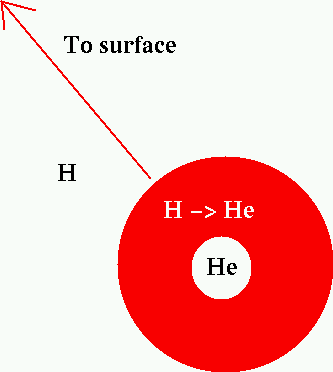Red Giant Stars
As the inert He core contracts, regions of the star just
outside the core heat up as well, until they reach temperatures where they
can fuse H -> He. Hydrogen shell burning commences:
Inside the core:

-
This shell actually produces more energy than the normal
hydrogen burning core phase did, so luminosity rises.
-
Not all the energy escapes; some goes into expanding the
star: radius rises, surface temperature drops.
-
The star becomes a subgiant star.
As more and more helium "ash" is being added to the
core, it keeps contracting to maintain pressure and hold up the star. Once
the amount of mass in the helium core reaches about 8% of the star mass
(the Schonberg-Chandrasekhar Limit),
the density becomes so high that the core no longer acts like a perfect
gas. It becomes degenerate.
Electron degeneracy - back to quantum mechanics!
Electrons obey a quantum mechanical principle
known as the Pauli Exclusion Principle:
no two electrons can share the same quantum state.
What does this mean? Electrons want to sit in the
lowest possible energy state. They can't all do that. So the higher the
density, the more the electrons have to exist in higher and higher energy
states. More energy --> more motion --> higher pressure.
If the gas is completely degenerate, the follow an equation
of state which is given by
 Note: no temperature dependence!
Note: no temperature dependence!
So we have:
-
an inert helium core supported by electron degeneracy,
-
a hydrogen burning shell
-
an expanding outer envelope
This leads to...
The Red Giant Ascent
As the star expands, it cools. At this point, the H-
ion can form, when a neutral hydrogen atom "grabs" a free
electrons (from partial ionization of other elements). It is very easy
to for radiation to be absorbed by, and ionize, the H- ion --
so opacity is high.
High opacity + high energy
generation = convection! The whole outer envelope becomes
convective, and processed material in the core can rise to the surface,
a process known as dredge-up.
As the outer layers continue to expand, ionization drops
so there are fewer free electrons and fewer H- ions. Opacity
drops and luminosity keeps increasing (due to core contraction).
The star becomes a red giant:
-
L > 100 Lsun
-
Te ~ 4000 K
-
R ~ 30 - 100 Rsun
-
examples: Arcturus & Aldebaran
Meanwhile, down in the core...
...temperature keeps rising. When the temperature gets high
enough (100 million degrees), Helium can begin to fuse together to form
Carbon in the triple alpha process.
but the core is degenerate:  so
that when temperature rises, pressure does not: the core can't expand and
cool... so energy raises temperature raises energy raises temperature raises
energy raises temperature: a runaway!
so
that when temperature rises, pressure does not: the core can't expand and
cool... so energy raises temperature raises energy raises temperature raises
energy raises temperature: a runaway!
When the triple alpha process kicks in, 1011
Lsun is released in a few seconds: the
helium core flash.
None of the energy makes it out of the star. Instead it
lifts the electron degeneracy (making it behave again like an ideal gas)
and expands the core a bit. So we now have:
-
a helium burning core
-
a hydrogen burning shell (providing most of the luminosity)
-
an extended envelope
but since the core expands, it cools and the energy generation
in the hydrogen burning shell drops. The luminosity
decreases, the star shrinks, and the surface temperature rises.
The star becomes a horizontal branch star.


 so
that when temperature rises, pressure does not: the core can't expand and
cool... so energy raises temperature raises energy raises temperature raises
energy raises temperature: a runaway!
so
that when temperature rises, pressure does not: the core can't expand and
cool... so energy raises temperature raises energy raises temperature raises
energy raises temperature: a runaway!